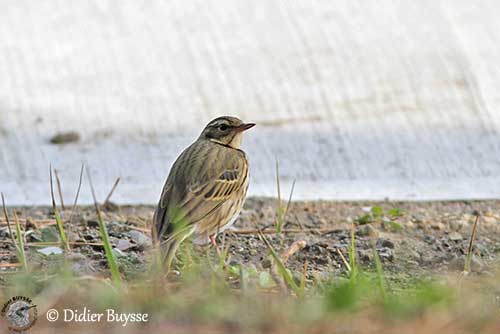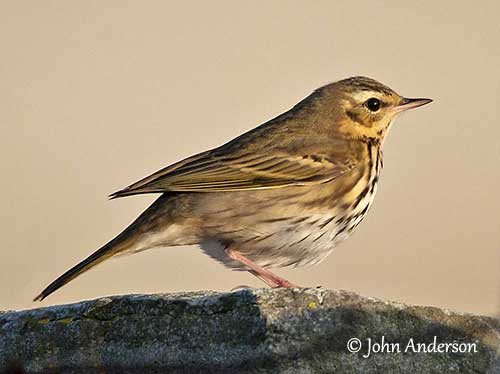
Fr: Pipit à dos olive
Ang: Olive-backed Pipit
All: Waldpieper
Esp: Bisbita de Hodgson
Ita: Prispolone indiano
Nd: Siberische Boompieper
Sd: sibirisk piplärka
Photographers:
John Anderson
John Anderson Photo Galleries
Didier Buysse
Vision d’Oiseaux
William Price
PBase-tereksandpiper & Flickr William Price
Ingo Waschkies
Bird Photography
Text by Nicole Bouglouan
Sources:
HANDBOOK OF THE BIRDS OF THE WORLD Vol 9 - by Josep del Hoyo - Andrew Elliot - David Christie - Lynx Edicions - ISBN: 8487334695
The Sound Approach - Separation from Tree Pipit
AVESRARES - Identification of Olive-backed and Tree Pipit by call
What Bird-The ultimate Bird Guide (Mitchell Waite)
Wikipedia, the free encyclopaedia
Home page
Page Passeriformes Order
Olive-backed Pipit
Anthus hodgsoni
Passeriformes Order – Motacillidae Family
INTRODUCTION:
The Olive-backed Pipit is native to Eurasia and breeds across southern, central and eastern Asia, and in some parts of European Russia. It is a long-distance migrant and moves southwards to spend the winter in southern Asia and Indonesia.
This species breeds mainly in wooded habitats, and up to 4,000 metres of elevation in Himalayas. During winter, it frequents evergreen woodlands, groves and plantations. It nests in a cup-shaped structure placed on the ground protected by tall grass or rock.
It feeds primarily on insects, but it also takes seeds depending on the season. It forages on the ground and walks along branches in trees while probing for insects.
The Olive-backed Pipit is described as common to locally common and the population seems to be stable. It is not globally threatened.
The name of this species pays tribute to Brian Houghton Hodgson, an English naturalist and ethnologist working in India and Nepal.

DESCRIPTION OF THE BIRD:
Biometrics:
Length: 15-19 cm
Wingspan: 24-27 cm
Weight: 17-26 g
The Olive-backed Pipit resembles the Red-throated Pipit - Anthus cervinus but it lacks the pinkish-red head sides and throat. It is also closely related to Tree Pipit - Anthus trivialis and both races sometimes interbreed.
The Olive-backed Pipit of nominate race has greenish-olive upperparts with black streaks on mantle. On the upperwing, the lesser coverts are greenish-olive whereas other wing feathers are mostly blackish, with greenish/yellowish edges. The pale tips of the median coverts form a double wingbar. The uppertail is blackish and edged green.
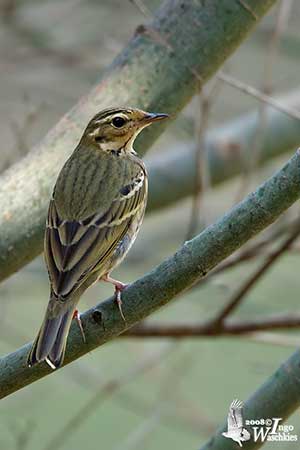
The underparts are whitish to buff with dark brown streaks on breast and flanks. Chin to upper breast is yellowish-buff to whitish. The lower flanks are tinged olive. On the underwing, axillaries and wing-coverts are yellow to buff.
The head is greenish-olive with black streaking on crown and forehead. We can see a broad, whitish to creamy supercilium bordered with black above. On the rear of the ear-coverts, there is a white spot above a black marking. The narrow malar stripe is black and contrasts strongly with the broad, white moustachial stripe.
The bill is dark brown but the base of the lower mandible is pinkish. The eyes are dark brown. Legs and feet are pinkish.
Male and female are similar.
The juvenile has browner upperparts and longer streaks on the underparts, but less distinct.
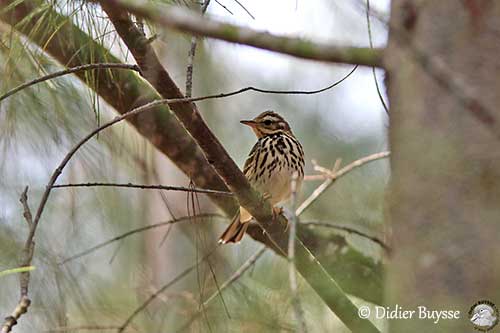
SUBSPECIES AND RANGE:
The Olive-backed Pipit has two subspecies.
A.h. hodgsoni (described above) breeds in Himalayas, E to C China, and also in N Korea and Japan. It winters in S and SE Asia.
A.h. yunnanensis breeds in NW Russia, E to Kamchatka, Sakhalin and Kuril Islands, S to N Mongolia, NE China and N Japan. It winters in S and SE Asia.
This race has much less conspicuous streaks on mantle (it may appear plain), and the streaking of the underparts is slightly narrower.
HABITAT:
The Olive-backed Pipit breeds at the edge of coniferous taiga forest, along river banks and on fringes of bogs and marshes. It nests on slopes with grass and ferns, also on rocky ground and in clearings in open forest of oak, birch, alder, fir or pine, in wooded and abandoned cultivated fields, in scrubby areas with scattered trees, and in shady parts of paddyfields. It may occur above the timber-line in dwarf juniper or other shrub species.
It breeds up to 4,000 metres of elevation in Himalayas. After breeding, it moves to the Himalayan foothills around 2,500 metres. In other range, it spends the winter in suitable wooded areas on hills and on plains.
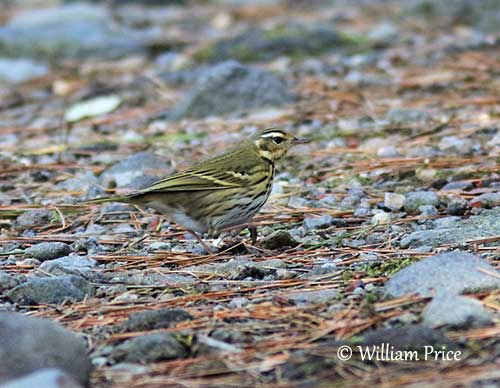
CALLS AND SONGS: SOUNDS BY XENO-CANTO
The calls of the Olive-backed Pipit include a loud “teaze”. In flight, the bird gives a thin “teez” or “tseep”. At rest, it produces a high, thin “tsi” or “sip” almost inaudible.
Most sounds are very similar to those of the Tree Pipit, but in the present species, the “sip” call is much higher-pitched and readily distinguished from the “süt” of the Tree Pipit. In the call of the Olive-backed Pipit, the “sip” or “sit” note does not carry very far and it sounds weak and difficult to hear and it is easily missed.
The song is given in flight or from treetop. This song consists of rapidly repeated single trilled phrases and short, dry rattles.
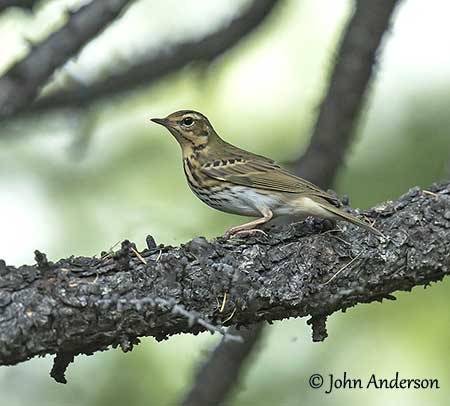
BEHAVIOUR IN THE WILD:
The Olive-backed Pipit feeds primarily on insects, adults and larvae, of several species such as Lepidopterans, Dipterans, Coleopterans and Hemipterans, and also weevils. But the diet also includes seeds of weeds and grass outside of the breeding season.
It forages on the ground among the grass and close to the vegetal cover. If disturbed or alarmed, it flies in to tree and walks along the branches while probing for insects.
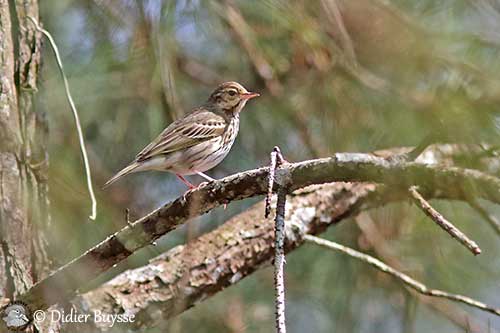
At the beginning of the breeding season, the male performs aerial displays while singing. It takes flight from tree perch and rises obliquely to 15-30 metres, before to make a parachute-flight to descend directly or in arcs. During this flight, the wings are open and the tail spread, while the legs are dangling.
The Olive-backed Pipit nests on the ground in shelter of grass or rock. They are monogamous.
This species is migratory and moves over long distances after breeding, migrating southwards to spend the winter in more temperate regions. They leave the breeding grounds from late August, and return to them from mid-May to early June.
The southern populations also move southwards. Vagrants occur in NW Europe and in Middle East, less frequently in Mediterranean regions. The species also wanders to W USA on St. Lawrence Island and Pribilof Islands, but it is rarer in W Aleutian Islands.
The Olive-backed Pipit flies with series of rapid wingbeats interspersed with glides during which the wings are pulled to the sides.
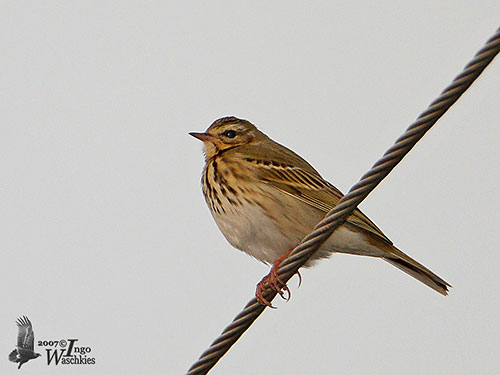
REPRODUCTION OF THIS SPECIES:
The race “yunnanensis” breeds in June-August in W Siberia, whereas the nominate race breeds from May to end July-August in S of the range. This species produces two broods per season.
The cup-shaped nest is made with moss and dry grass, and the cup is lined with softer grass and animal hair. It is built on the ground, protected by tuft of grass or rock, or placed in shallow depression.
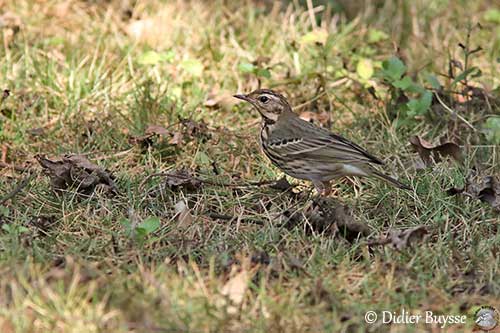
The female lays 4-5 greyish eggs with dark blotches. She incubates probably alone during 12-13 days. Both parents feed the chicks. The young leave the nest 11-12 days after hatching, and depend on adults during 1-2 days, until they are able to fly.
PROTECTION / THREATS / STATUS:
The Olive-backed Pipit has very large range in which it is common to locally common.
The size of the global population is unknown. The European breeding population (<5% of global range) is estimated to number 45,000/60,000 pairs, equating to 90,000/120,000 mature individuals.
The population is suspected to be stable and not globally threatened. The Olive-backed Pipit is currently evaluated as Least Concern.
